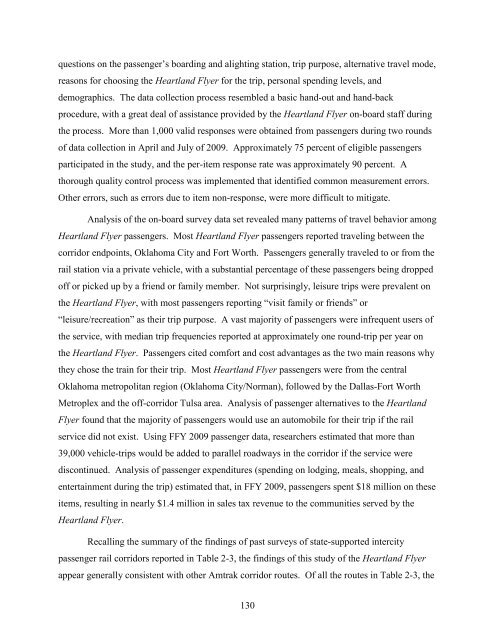Measuring the Benefits of Intercity Passenger Rail: A Study
Measuring the Benefits of Intercity Passenger Rail: A Study
Measuring the Benefits of Intercity Passenger Rail: A Study
You also want an ePaper? Increase the reach of your titles
YUMPU automatically turns print PDFs into web optimized ePapers that Google loves.
questions on <strong>the</strong> passenger’s boarding and alighting station, trip purpose, alternative travel mode,<br />
reasons for choosing <strong>the</strong> Heartland Flyer for <strong>the</strong> trip, personal spending levels, and<br />
demographics. The data collection process resembled a basic hand-out and hand-back<br />
procedure, with a great deal <strong>of</strong> assistance provided by <strong>the</strong> Heartland Flyer on-board staff during<br />
<strong>the</strong> process. More than 1,000 valid responses were obtained from passengers during two rounds<br />
<strong>of</strong> data collection in April and July <strong>of</strong> 2009. Approximately 75 percent <strong>of</strong> eligible passengers<br />
participated in <strong>the</strong> study, and <strong>the</strong> per-item response rate was approximately 90 percent. A<br />
thorough quality control process was implemented that identified common measurement errors.<br />
O<strong>the</strong>r errors, such as errors due to item non-response, were more difficult to mitigate.<br />
Analysis <strong>of</strong> <strong>the</strong> on-board survey data set revealed many patterns <strong>of</strong> travel behavior among<br />
Heartland Flyer passengers. Most Heartland Flyer passengers reported traveling between <strong>the</strong><br />
corridor endpoints, Oklahoma City and Fort Worth. <strong>Passenger</strong>s generally traveled to or from <strong>the</strong><br />
rail station via a private vehicle, with a substantial percentage <strong>of</strong> <strong>the</strong>se passengers being dropped<br />
<strong>of</strong>f or picked up by a friend or family member. Not surprisingly, leisure trips were prevalent on<br />
<strong>the</strong> Heartland Flyer, with most passengers reporting “visit family or friends” or<br />
“leisure/recreation” as <strong>the</strong>ir trip purpose. A vast majority <strong>of</strong> passengers were infrequent users <strong>of</strong><br />
<strong>the</strong> service, with median trip frequencies reported at approximately one round-trip per year on<br />
<strong>the</strong> Heartland Flyer. <strong>Passenger</strong>s cited comfort and cost advantages as <strong>the</strong> two main reasons why<br />
<strong>the</strong>y chose <strong>the</strong> train for <strong>the</strong>ir trip. Most Heartland Flyer passengers were from <strong>the</strong> central<br />
Oklahoma metropolitan region (Oklahoma City/Norman), followed by <strong>the</strong> Dallas-Fort Worth<br />
Metroplex and <strong>the</strong> <strong>of</strong>f-corridor Tulsa area. Analysis <strong>of</strong> passenger alternatives to <strong>the</strong> Heartland<br />
Flyer found that <strong>the</strong> majority <strong>of</strong> passengers would use an automobile for <strong>the</strong>ir trip if <strong>the</strong> rail<br />
service did not exist. Using FFY 2009 passenger data, researchers estimated that more than<br />
39,000 vehicle-trips would be added to parallel roadways in <strong>the</strong> corridor if <strong>the</strong> service were<br />
discontinued. Analysis <strong>of</strong> passenger expenditures (spending on lodging, meals, shopping, and<br />
entertainment during <strong>the</strong> trip) estimated that, in FFY 2009, passengers spent $18 million on <strong>the</strong>se<br />
items, resulting in nearly $1.4 million in sales tax revenue to <strong>the</strong> communities served by <strong>the</strong><br />
Heartland Flyer.<br />
Recalling <strong>the</strong> summary <strong>of</strong> <strong>the</strong> findings <strong>of</strong> past surveys <strong>of</strong> state-supported intercity<br />
passenger rail corridors reported in Table 2-3, <strong>the</strong> findings <strong>of</strong> this study <strong>of</strong> <strong>the</strong> Heartland Flyer<br />
appear generally consistent with o<strong>the</strong>r Amtrak corridor routes. Of all <strong>the</strong> routes in Table 2-3, <strong>the</strong><br />
130
















